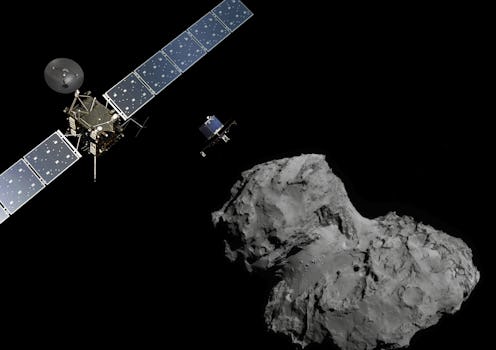News
A Space Probe Is Finally Awake & Talking To Earth
After a seven-month nap, a comet lander named Philae has woken up. The space probe slipped into hibernation after traveling 6.4 billion miles and touching down on comet 67P/Churyumov-Gerasimenko in November, according to CNN. Since waking up, the space probe has been sending data back to earth. Scientists are trying to shake the sleepy probe enough so that it will relay its location on the comet, which has been a mystery.
The European Space Agency told the AP that after its first launch, Philae managed to collect data on the icy surface of the comet, which is near the orbit of Mars, for about 60 hours before its batteries were depleted and it was forced to shut its systems down. Since then, scientists have been waiting for the probe to approach the sun so that its solar panels could soak up enough light to charge the battery. When Philae woke up, it started sending back data late Saturday night. It sent about 300 packages of data relayed by its mother ship, Rosetta, which is orbiting the comet. Stephan Ulamec, project manager at the German Aerospace Center, or DLR, told the AP they received data for about 85 seconds and that most of it was "housekeeping" and system data. He said it was enough to tell scientists that Philae is doing well and getting enough sunlight to continue communicating:
I'm not really surprised it happened, but if you wait for several months and then suddenly in the middle of the night you get a call saying 'we have a signal from Philae,' it's exciting. We're very happy.
Philae, which was described by the Atlantic as a "washing-machine-sized robot" was traveling through space with Rosetta for about 10 years before detaching and landing on the comet in November. The landing was a bit bouncier than expected, so the probe's exact location has been unknown. Once the first battery pack died, scientists were afraid the probe might have landed in an area without enough sunlight to recharge the second battery pack.
Scientists said the pack not only got enough sunlight to bring Philae back to life, but it has also been keeping Philae charged while collecting data for a number of days before this first initial contact with earth. Now scientists are waiting for the next contact, according to the ESA blog:
There are still more than 8,000 data packets in Philae’s mass memory which will give the DLR team information on what happened to the lander in the past few days on Comet 67P/Churyumov-Gerasimenko.
Scientists are waiting on Philae's exact location, and they also hope to learn more about the shape, density, temperature, and chemical make-up of the comet, according to the Atlantic. They also hope to analyze how the comet responds to cosmic dust and solar wind. Scientists told the AP that they will now work to change Rosetta's orbit so that its link to Philae will last for longer, allowing them to send commands for the probe to start carrying out different measurements. Ulamec told the AP that the next opportunity to communicate with Philae will happen Sunday night. He said the probe will get enough sunlight on the comet to operate until October, but then it could go silent forever.
Matt Taylor, a project scientist at the ESA, told CNN that it's important for us to understand how comets work "to understand where we came from, to get an idea of where we should be going":
We have been to comets before with spacecraft, observed them for centuries from the ground, but for the first time with Rosetta, we will "live" alongside a comet for over a year, sniffing and tasting it, scratching it with the lander, seeing how it is made up and how it evolves in time with its interaction with energy of the Sun. ... Comets are considered frozen relics of the formation of the solar system and examining comets provides us with an insight into the conditions and composition of that time. We are doing archaeology into how our planet was formed and evolved to what we live on today.
Images: Getty Images (1)
